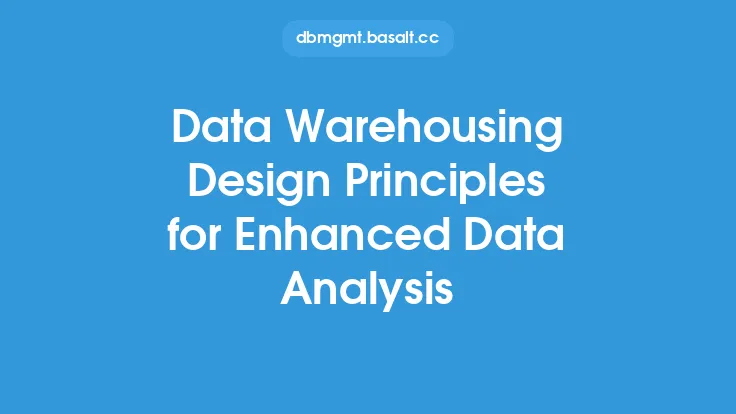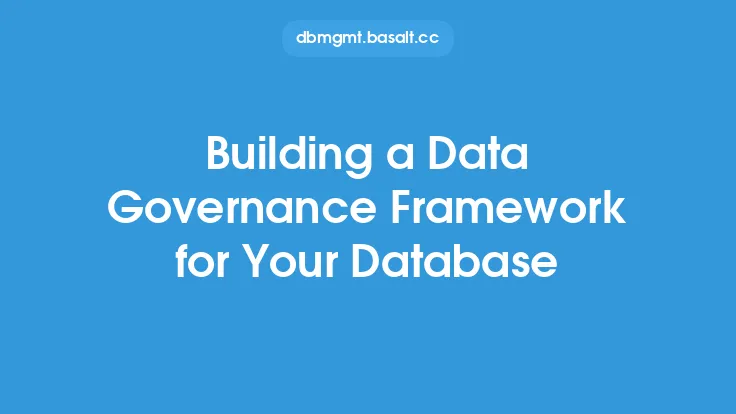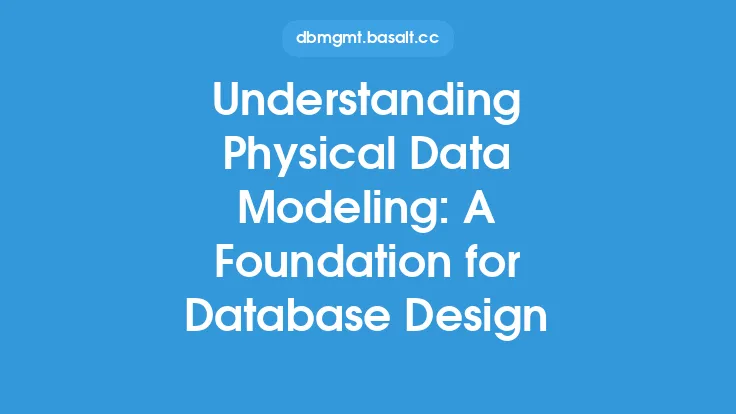When designing a database, it's essential to consider the principles of data governance to ensure that the data is accurate, reliable, and secure. Data governance refers to the overall management of the availability, usability, integrity, and security of an organization's data. Effective data governance is critical to ensuring that an organization's data is trustworthy and can be used to make informed decisions. In this article, we'll explore the key principles of data governance for database design and how they can be applied to ensure the quality and integrity of an organization's data.
Introduction to Data Governance Principles
Data governance principles provide a framework for managing an organization's data assets. These principles are designed to ensure that data is accurate, complete, and consistent across the organization. They also help to ensure that data is properly secured and that access to sensitive data is restricted to authorized personnel. Some of the key principles of data governance include data quality, data security, data integrity, and data compliance. By applying these principles, organizations can ensure that their data is reliable and trustworthy, and that it can be used to make informed decisions.
Data Quality Principles
Data quality is a critical aspect of data governance. It refers to the accuracy, completeness, and consistency of an organization's data. To ensure data quality, organizations should establish clear standards and procedures for data entry, data validation, and data cleansing. This can include implementing data validation rules, using data profiling techniques to identify errors and inconsistencies, and establishing procedures for correcting and updating data. Additionally, organizations should regularly monitor and assess the quality of their data to identify areas for improvement. By ensuring data quality, organizations can trust that their data is accurate and reliable, and that it can be used to make informed decisions.
Data Security Principles
Data security is another critical aspect of data governance. It refers to the measures taken to protect an organization's data from unauthorized access, use, disclosure, modification, or destruction. To ensure data security, organizations should implement robust security measures, such as encryption, access controls, and authentication protocols. They should also establish clear policies and procedures for data access, data sharing, and data disposal. Additionally, organizations should regularly monitor and assess the security of their data to identify vulnerabilities and take corrective action. By ensuring data security, organizations can protect their data from cyber threats and ensure that it is only accessed by authorized personnel.
Data Integrity Principles
Data integrity refers to the consistency and accuracy of an organization's data across different systems and applications. To ensure data integrity, organizations should establish clear standards and procedures for data integration, data migration, and data synchronization. This can include implementing data mapping and data transformation techniques to ensure that data is consistent across different systems and applications. Additionally, organizations should regularly monitor and assess the integrity of their data to identify areas for improvement. By ensuring data integrity, organizations can trust that their data is consistent and accurate, and that it can be used to make informed decisions.
Data Compliance Principles
Data compliance refers to the measures taken to ensure that an organization's data is collected, stored, and used in compliance with relevant laws, regulations, and industry standards. To ensure data compliance, organizations should establish clear policies and procedures for data collection, data storage, and data use. They should also regularly monitor and assess the compliance of their data to identify areas for improvement. Additionally, organizations should ensure that their data is properly documented and that they can demonstrate compliance with relevant laws and regulations. By ensuring data compliance, organizations can avoid fines and penalties, and ensure that their data is used in a responsible and ethical manner.
Applying Data Governance Principles to Database Design
When designing a database, it's essential to apply the principles of data governance to ensure that the data is accurate, reliable, and secure. This can include implementing data validation rules, using data profiling techniques to identify errors and inconsistencies, and establishing procedures for correcting and updating data. Additionally, database designers should consider the security and integrity of the data, and implement robust security measures, such as encryption and access controls. By applying the principles of data governance to database design, organizations can ensure that their data is trustworthy and can be used to make informed decisions.
Best Practices for Data Governance in Database Design
There are several best practices that organizations can follow to ensure effective data governance in database design. These include establishing clear standards and procedures for data entry, data validation, and data cleansing, as well as implementing robust security measures, such as encryption and access controls. Additionally, organizations should regularly monitor and assess the quality, security, and integrity of their data to identify areas for improvement. By following these best practices, organizations can ensure that their data is accurate, reliable, and secure, and that it can be used to make informed decisions.
Conclusion
In conclusion, data governance principles are essential for ensuring the quality, security, and integrity of an organization's data. By applying these principles to database design, organizations can ensure that their data is trustworthy and can be used to make informed decisions. Effective data governance requires a combination of people, processes, and technology, and organizations should establish clear policies and procedures for data governance, as well as implement robust security measures and data quality controls. By prioritizing data governance, organizations can protect their data assets, ensure compliance with relevant laws and regulations, and make informed decisions that drive business success.





